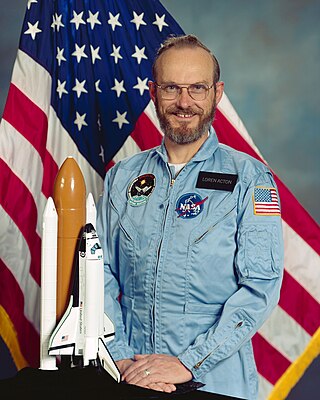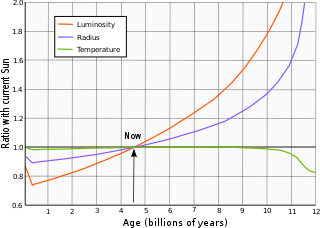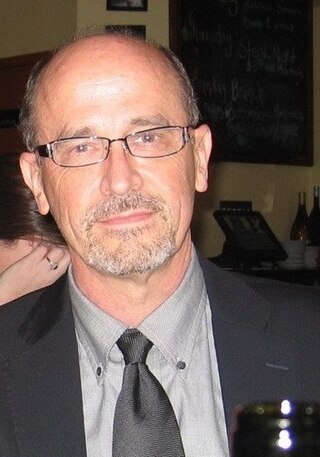Related Research Articles

Loren Wilber Acton is an American physicist who flew on Space Shuttle mission STS-51-F as a Payload Specialist for the Lockheed Palo Alto Research Laboratory. He is also the father of Cheryll Glotfelty, a leading ecocritic.

The solar mass (M☉) is a standard unit of mass in astronomy, equal to approximately 2×1030 kg. It is often used to indicate the masses of other stars, as well as stellar clusters, nebulae, galaxies and black holes. It is approximately equal to the mass of the Sun. This equates to about two nonillion (short scale), two quintillion (long scale) kilograms or 2000 quettagrams:

The solar luminosity (L☉) is a unit of radiant flux conventionally used by astronomers to measure the luminosity of stars, galaxies and other celestial objects in terms of the output of the Sun.

The American Astronomical Society is an American society of professional astronomers and other interested individuals, headquartered in Washington, DC. The primary objective of the AAS is to promote the advancement of astronomy and closely related branches of science, while the secondary purpose includes enhancing astronomy education and providing a political voice for its members through lobbying and grassroots activities. Its current mission is to enhance and share humanity's scientific understanding of the universe as a diverse and inclusive astronomical community.

George Ellery Hale was an American astrophysicist, best known for his discovery of magnetic fields in sunspots, and as the leader or key figure in the planning or construction of several world-leading telescopes; namely, the 40-inch refracting telescope at Yerkes Observatory, 60-inch Hale reflecting telescope at Mount Wilson Observatory, 100-inch Hooker reflecting telescope at Mount Wilson, and the 200-inch Hale reflecting telescope at Palomar Observatory. He played a key role in the foundation of the International Union for Cooperation in Solar Research and the National Research Council, and in developing the California Institute of Technology into a leading research university.
Jeremiah Paul "Jerry" Ostriker is an American astrophysicist and a professor of astronomy at Columbia University and is the Charles A. Young Professor Emeritus at Princeton where he also continues as a senior research scholar. Ostriker has also served as a university administrator as Provost of Princeton University.

The Indian Institute of Astrophysics (IIA), with its headquarters in Bengaluru, is an autonomous research institute wholly funded by the Department of Science and Technology, Government of India. IIA conducts research primarily in the areas of astronomy, astrophysics and related fields.

The Kodaikanal Solar Observatory is a solar observatory owned and operated by the Indian Institute of Astrophysics. It is on the southern tip of the Palani Hills 4 kilometres (2.5 mi) from Kodaikanal.

Anil Kumar Das FRAS, FNI was an Indian scientist, astronomer. During the International Geophysical Year, observatories in Madrid, India, and Manila were responsible for monitoring solar effects. The Kodaikanal Solar Observatory in South India performed this monitoring using their recently built solar tunnel telescope. Das was the director of the Kodaikanal observatory at this time. In 1960 he was responsible for installing a tower/tunnel telescope at the facility that would be used to perform some of the first helioseismology investigations. The crater Das on the far side of the Moon is named after him.
Eric Ronald Priest is Emeritus Professor at St Andrews University, where he previously held the Gregory Chair of Mathematics and a Bishop Wardlaw Professorship.
The George Ellery Hale Prize, or Hale Prize, is awarded annually by the Solar Physics Division of the American Astronomical Society for outstanding contributions over an extended period of time to the field of solar astronomy. The prize is named in memory of George Ellery Hale.

Nicholas B. Suntzeff is an American astronomer and cosmologist. He is a University Distinguished Professor and holds the Mitchell/Heep/Munnerlyn Chair of Observational Astronomy in the Department of Physics & Astronomy at Texas A&M University where he is Director of the Astronomy Program. He is an observational astronomer specializing in cosmology, supernovae, stellar populations, and astronomical instrumentation. With Brian Schmidt he founded the High-z Supernova Search Team, which was honored with the Nobel Prize in Physics in 2011 to Schmidt and Adam Riess.
An active region is a temporary region in the Sun's atmosphere characterized by a strong and complex magnetic field. They are often associated with sunspots and are commonly the source of violent eruptions such as coronal mass ejections and solar flares. The number and location of active regions on the solar disk at any given time is dependent on the solar cycle.
Alycia J. Weinberger is a staff member at the Carnegie Institution of Washington. Before joining the Carnegie scientific staff in 2001, she was a Near Infrared Camera and Multi-Object Spectrometer (NICMOS) postdoctoral researcher and astrobiology postdoctoral fellow at University of California, Los Angeles (UCLA). She received her B.A. in Physics from the University of Pennsylvania and her PhD from Caltech. She is the 2000 winner of the Annie J. Cannon Award in Astronomy and the Vainu Bappu Gold Medal of Astronomical Society of India for 2000. In 2019 she was selected to become a fellow of the American Astronomical Society.
The Astronomical Society of India (ASI) is an Indian society of professional astronomers and other professionals from related disciplines. It was founded in 1972, with Vainu Bappu being the founder President of the Society, and as of 2010 has a membership of approximately 1000. Its registered office is at the Astronomy Department, Osmania University, Hyderabad, India. Its primary objective is the promotion of Astronomy and related branches of science. It organises meetings, supports and tries to popularise Astronomy and related subjects and publishes the Bulletin of the Astronomical Society of India.
Douglas Owen Gough FRS is a British astronomer, Professor Emeritus of Theoretical Astrophysics in the University of Cambridge, and Leverhulme Emeritus Fellow.

Claudia Megan Urry is an American astrophysicist, who has served as the President of the American Astronomical Society, as chair of the Department of Physics at Yale University, and as part of the Hubble Space Telescope faculty. She is currently the Israel Munson Professor of Physics and Astronomy at Yale University and Director of the Yale Center for Astronomy and Astrophysics. Urry is notable not only for her contributions to astronomy and astrophysics, including work on black holes and multiwavelength surveys, but also for her work addressing sexism and sex equality in astronomy, science, and academia more generally.
Yvonne Elsworth FRS FInstP FRAS is an Irish physicist, Professor of Helioseismology and Poynting Professor of Physics in the School of Physics and Astronomy at the University of Birmingham. Elsworth was until 2015 also the Head of the Birmingham Solar Oscillations Network (BiSON), the longest running helioseismology network with data covering well over three solar cycles.
Shashikumar Madhusudan Chitre FNA, FASc, FNASc, FRAS was an Indian mathematician and astrophysicist, known for his research in Astronomy and Astrophysics. The Government of India honored him, in 2012, with Padma Bhushan, the third highest civilian award, for his services to the sciences.

Nirupama Raghavan was an Indian astrophysicist, weather scientist, historian of science and educator. She was the Director of the Nehru Planetarium in New Delhi.
References
- 1 2 3 4 5 "Sarbani Basu, CV". www.astro.yale.edu. Retrieved 20 May 2018.
- ↑ "Professor M. K. Vainu Bappu Gold Medal | Astronomical Society of India". www.astron-soc.in. Retrieved 20 May 2018.
- ↑ "Sarbani Basu". Institute for Advanced Study. Retrieved 20 May 2018.
- ↑ Kumar, Pawan; Basu, Sarbani (1999). "Line Asymmetry of Solar p-Modes: Properties of Acoustic Sources". The Astrophysical Journal. 519 (1): 396–399. arXiv: astro-ph/9808143 . Bibcode:1999ApJ...519..396K. doi: 10.1086/307369 .
- ↑ "Sarbani Basu". www.astro.yale.edu. Retrieved 20 May 2018.
- ↑ Basu, Sarbani (2016). "Global Seismology of the Sun". Living Reviews in Solar Physics. 13 (1): 2. arXiv: 1606.07071 . Bibcode:2016LRSP...13....2B. doi:10.1007/s41116-016-0003-4. ISSN 2367-3648. S2CID 118486913.
- ↑ "Sarbani Basu". Interseismology. Retrieved 20 May 2018.
- ↑ Basu, Sarbani; Antia, H.M. (2008). "Helioseismology and solar abundances". Physics Reports. 457 (5–6): 217–283. arXiv: 0711.4590 . Bibcode:2008PhR...457..217B. doi:10.1016/j.physrep.2007.12.002. ISSN 0370-1573. S2CID 119302796.
- ↑ Basu, Sarbani (January 2014). Asteroseismology. Cambridge: Cambridge University Press. pp. 87–122. doi:10.1017/CBO9781139333696.005. ISBN 9781139333696.
- ↑ "Sarbani Basu - Google Scholar Citations". scholar.google.co.uk. Retrieved 20 May 2018.
- ↑ School, Taft (24 January 2017), Morning Meeting, 1/24/17: Sarbani Basu, Professor of Astronomy, Yale University , retrieved 20 May 2018
- ↑ "4/30/18: Public Evening Lecture: Dr. Sarbani Basu, Yale Univ". www.as.arizona.edu. Retrieved 20 May 2018.
- ↑ "Basu elected Fellow of AAAS". astronomy.yale.edu. Retrieved 20 May 2018.
- ↑ Basu, Sarbani; Chaplin, William J. (5 September 2017). Asteroseismic Data Analysis. ISBN 9780691162928 . Retrieved 20 May 2018.
{{cite book}}:|website=ignored (help) - ↑ "Sarbani Basu wins 2018 George Ellery Hale Prize". YaleNews. 11 January 2018. Retrieved 20 May 2018.
- ↑ "2018 Hale Prize for Solar Astronomy Goes to Sarbani Basu". www.spaceref.com. Retrieved 20 May 2018.
- ↑ Staff Writer. "Yale Astronomer Sarbani Basu wins George Ellery Hale Prize". IndiaAbroad.com. Retrieved 20 May 2018.
- ↑ "Home - TESS 2018". connect.agu.org. Retrieved 20 May 2018.
- ↑ "AAS Fellows". AAS. Retrieved 27 September 2020.